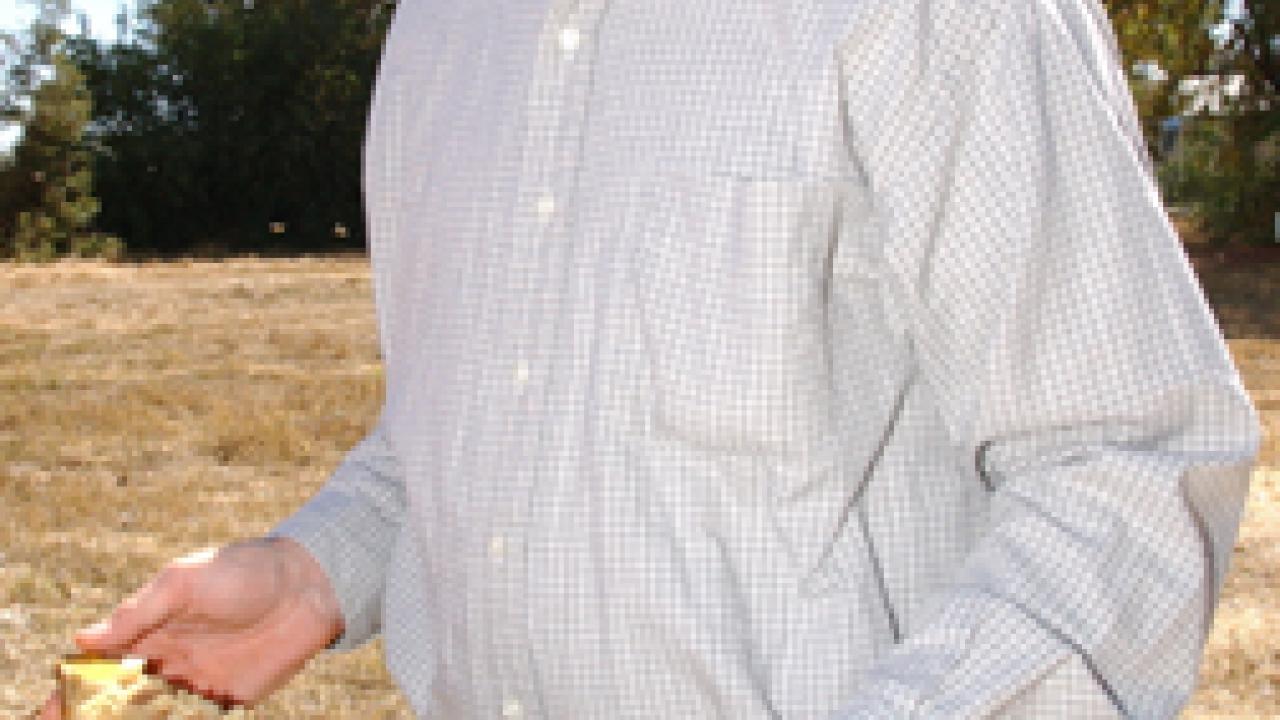UC Davis honeybee specialist Eric Mussen fingered some prime suspects during his "BSI: The Case of the Disappearing Bees" lecture, part of the UC Davis Department of Entomology's Distinguished Seminar Series.
Mussen identified malnutrition, parasitic mites, infectious microbes and insecticide contamination as among the possible culprits of colony collapse disorder, or CCD. He cited one certainty with this complex issue: "It seems unlikely that we will find a specific, new and different reason for why bees are dying."
CCD, a phenomenon whereby bees mysteriously abandon their hives, is not a new occurrence, said Mussen, extension apiculturist at UC Davis since 1976.
Similar phenomena have been ob-served since 1869, he said. "It persisted in 1963, 1964 and 1965 and was called 'spring dawdling,' 'fall collapse' and 'autumn collapse.' Then, in 1975, it was called 'disappearing disease.'
"But the disease wasn't what was disappearing," Mussen quipped. "The bees were."
Massive bee die-off also occurred during the winter of 2004-05, but only people who read bee journals knew about it, Mussen told his audience of 100 at the ARC. The latest die-off caught the attention of the national media last fall when a Pennsylvania beekeeper asked researchers at Penn State to look at samples of his dying bees in Pennsylvania and Florida. "The local media picked up the story and the rest is history, including yours truly on the (Jim) Lehrer (News) Hour."
Commercial beehives in the United States numbered approximately 2.3 million prior to CCD. Experts estimate a loss of one-third of the bees within those hives over the last year, as a result of CCD, in which nearly all adult worker bees unexpectedly fly away from their hives, abandoning stored honey, pollen, larvae and pupae. Usually the bees leave in less than a week, and only the queen and a few young workers remain, Mussen said.
Honeybees normally do not abandon their broods, he said. Nurse bees continually feed the young, which increase 1,000-fold in size in six days. "That's like an 8-pound baby weighing 4 tons in six days," Mussen said.
"The real reason bees are important is that we rely on them for crop pollination," said Mussen, who received the American Association of Professional Apiculturists' excellence award earlier this year for his bee industry leadership and research publications, and was named the California State Beekeepers Association's Beekeeper of the Year for 2006.
Commercial honeybees pollinate about 90 of the country's crops, valued at $15 billion.
"One-third of our U.S. diet depends on honeybees," Mussen said. "If bees produce fruits and vegetables somewhere else, do we (Americans) want to be as dependent on food as we are on oil?"
Bees are especially crucial to Califor-nia's 600,000 acres of almonds, he said. To pollinate the almonds, growers need 1.2 million beehives, "but California doesn't have 1.2 million bee hives, so they have to be trucked here." That, he said, can add to bee stress.
Mussen cited malnutrition as a key factor in CCD. Honeybee nutrition is "weather dependent," he said. "The best-fed bees are the healthiest, while malnourished bees are less resistant."
He posed these questions:
- Did weather events affect pollen-producing plants negatively?
- Was there a lack of bloom (nectar and pollen) due to lack of rain or too much heat?
- Was there reduced access to flowers due to excess rain?
- Did cold nights interfere with meiosis (cell division), leading to "sterile" or "non-viable" pollens?
- Do these types of pollen contain the usual proteins, vitamins, minerals and lipids required by the bees?
Mussen cast suspicion on several viruses, as well as the infectious microbes Nosema ceranae and Nosema apis, and seed treatments, including neonicotinoids, which are chemicals designed to mimic the toxic effects of a neurotoxin from the tobacco family. The nicotine-like insecticides kill fleas on cats and dogs.
Mussen said he hopes the national discussion will lead to more research and more research funding.
Kathy Keatley Garvey is a communications specialist with the Department of Entomology.
Media Resources
Dave Jones, Dateline, 530-752-6556, dljones@ucdavis.edu
